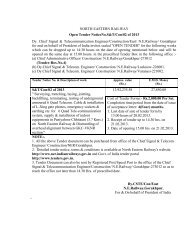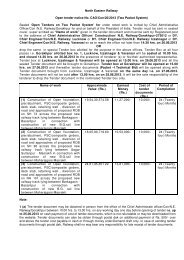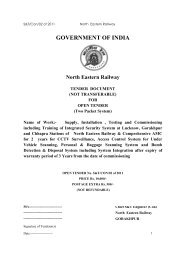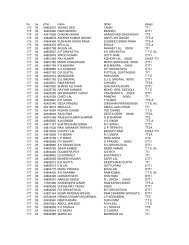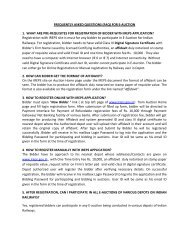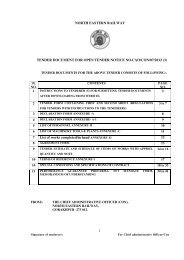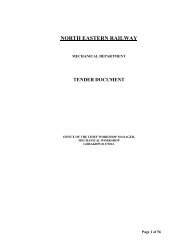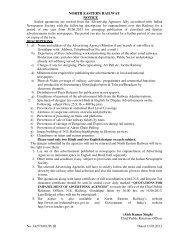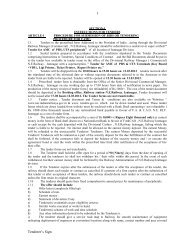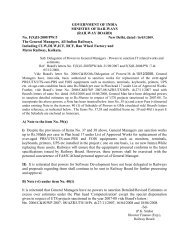GOVERNMENT OF INDIA North Eastern Railway ... - Tenders India
GOVERNMENT OF INDIA North Eastern Railway ... - Tenders India
GOVERNMENT OF INDIA North Eastern Railway ... - Tenders India
You also want an ePaper? Increase the reach of your titles
YUMPU automatically turns print PDFs into web optimized ePapers that Google loves.
Dy.CSTE/Con/ IZN/02 of 2011 <strong>North</strong> <strong>Eastern</strong> <strong>Railway</strong><br />
iii) For cable terminations in ASM's office as per Drg. No. Dy.CSTE/ CON /<br />
W – 52 /2005.<br />
iv) For cable jointing pit the cable trench as per Drg. No. CSTE/ CON /<br />
<strong>OF</strong>C – 18 /2001.<br />
2.13.2 Actual measurement should be made for the length for which special<br />
protection is necessary and the requirement of materials for the protective<br />
works should be worked out. The requirement of materials based on the actual<br />
measurement should be shown in the cable route plan at the appropriate place.<br />
2.14 SPECIAL PROBLEMS <strong>OF</strong> THE SECTION:<br />
2.14.1 Certain Sections may present special problems such as presence of chemically<br />
active soils, marshy areas, deep cuttings in the rocky areas, requirement of<br />
specially constructed platforms for distribution of cable drums along a high<br />
embankment etc.<br />
2.14.2 Approaches to large bridges may also present special problems due to high<br />
embankment as well as deep ravines.<br />
2.14.3 The survey party should inspect and report to Dy.CSTE/DSTE (whosoever is<br />
in-charge of field unit) such problems at the very outset so that suitable<br />
solutions can be worked out.<br />
2.15 ADDITIONAL MATERIALS REQUIRED FOR PROTECTIVE WORKS FOR <strong>OF</strong>C<br />
CABLES :- The minimum depth of trenches for <strong>OF</strong>C cables should be as described<br />
in the scheduleof work. <strong>OF</strong>C cable must be laid in HDPE pipe (HDPE duct) through<br />
out the route. This will avoid possible breakage of fibre due to vibrations of trains<br />
moving on track. The site engineer will remain present during progress of work, who<br />
will keep a watch on correct laying practice.<br />
2.16 COMMUNICATION ARRANGEMENT IN MAJOR YARDS & STATIONS<br />
In big yard and major stations involving large number of cabins/Depot/Tapping<br />
points, it may not be practicable to lay independent derivation cables for various<br />
locations. Therefore one main cable shall be laid to transverse in a zigzag way through<br />
the yard involving frequent tapping points. Lead sheath derivation., 6 quad or higher<br />
size PIJF cable may be laid for this purpose. The circuits should preferably be tapped<br />
through V.F. transformers.<br />
2.16.1 The typical layout of <strong>OF</strong>C hut is given in Drg. No. Dy.CSTE/Con/East/12.2001 (MW).<br />
2.16.2 There should be sufficient area available near the building for installation of earthing<br />
system. In certain locations this may require large area so as to achieve low resistance<br />
of earthing for which an electrode grid consisting of 30 or 40 rods with 5.0 meter<br />
spacing is to be installed or a large ring of earthing will have to be buried.<br />
2.16.3 Preference should be given for housing <strong>OF</strong>C cable hut in existing Microwave<br />
Repeaters, Telephone building etc.<br />
2.16.4 Selection of site for cable hut, route survey as well as laying of cables shall be<br />
in consultation with site engineer.<br />
Signature of Tenderer(s)<br />
Date…………………<br />
42



